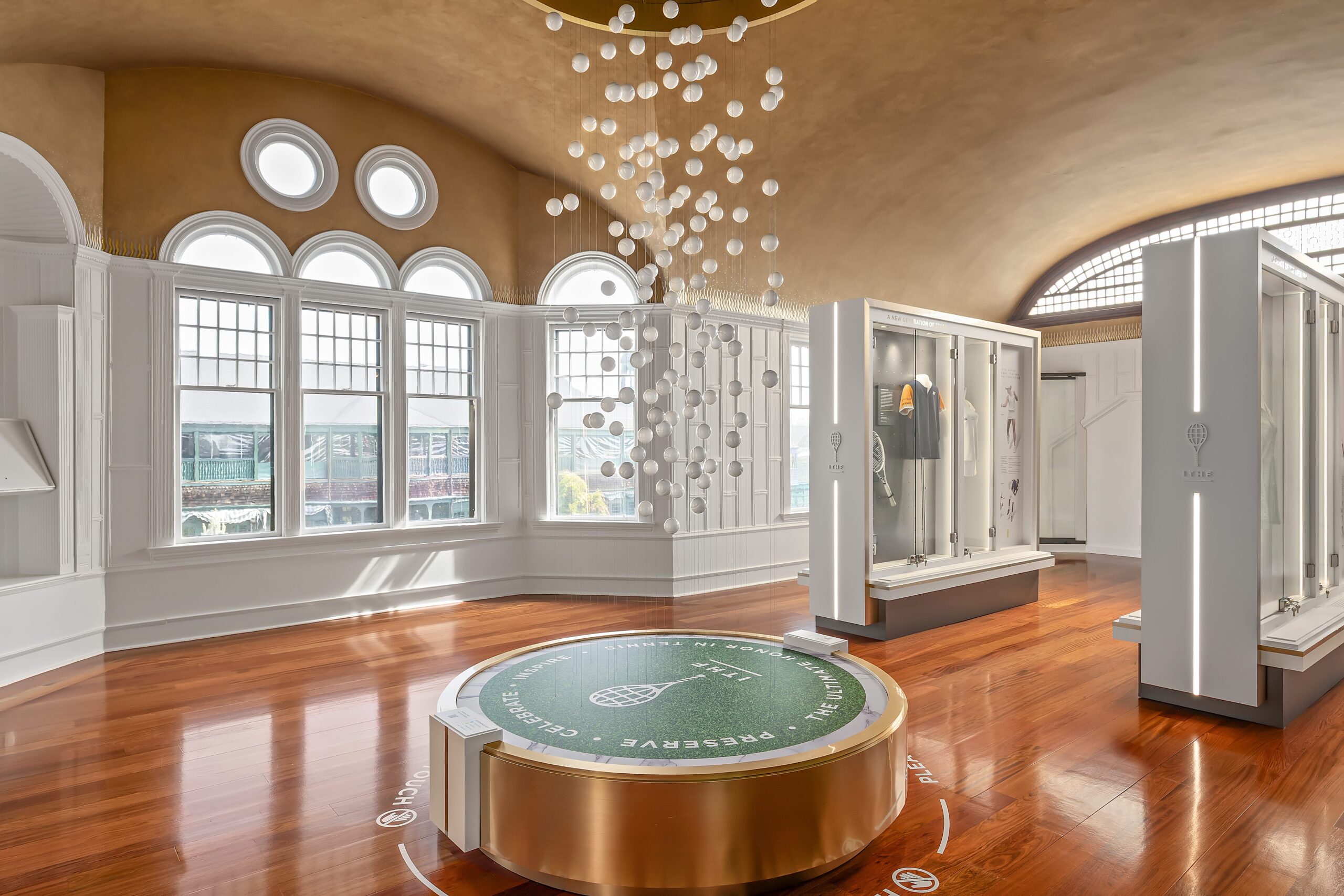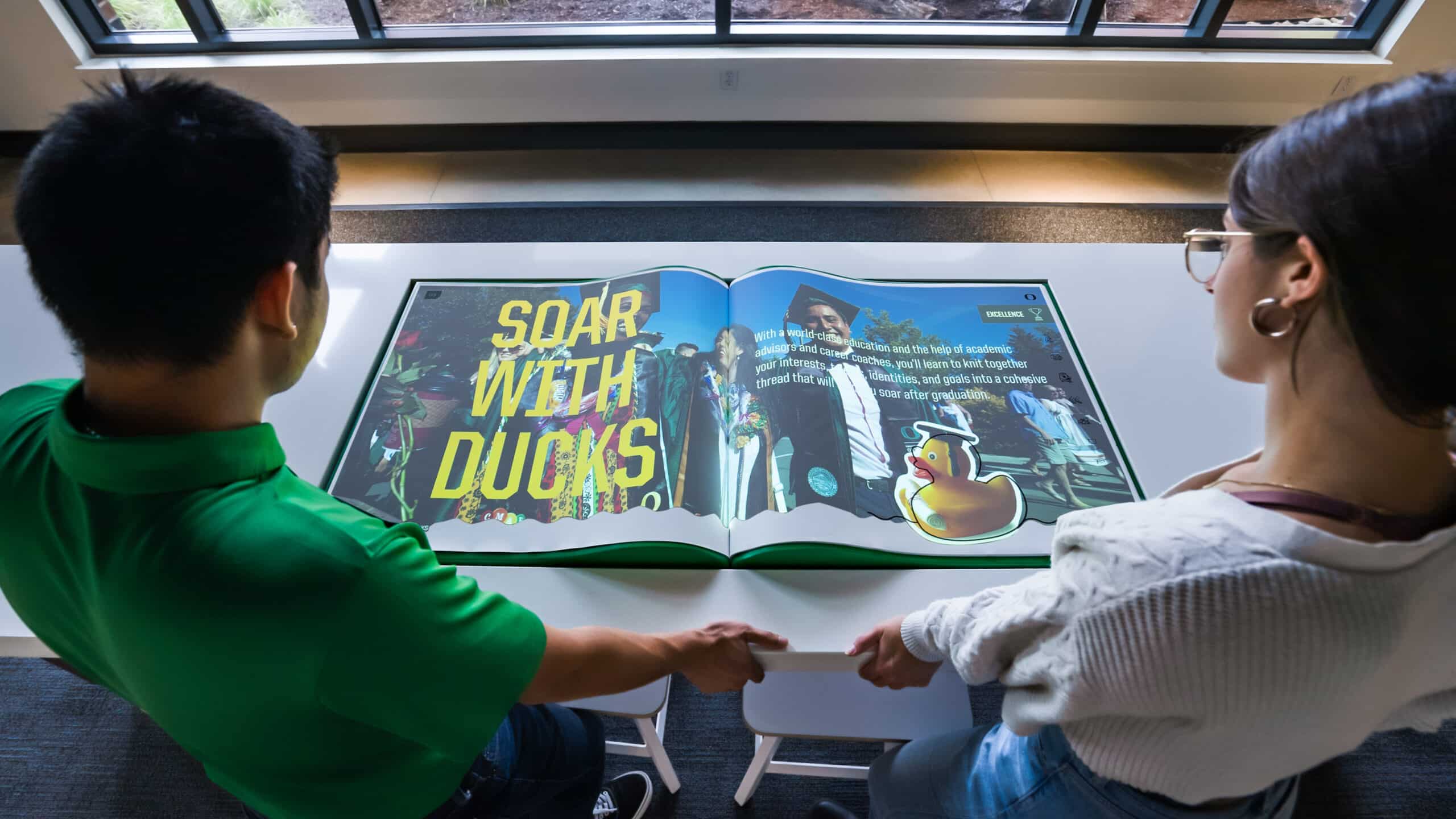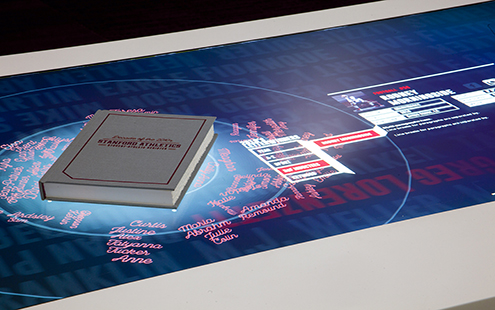Digital Experiences
Halls of Fame
How Technology Transformed Sports Hall of Fame Design

Introduction
For decades, sports halls of fame followed a predictable formula: glass cases filled with jerseys, plaques mounted on walls, and static displays that honored the past but rarely connected it to the present. Walk through any traditional hall of fame, and you’d find essentially the same experience: a museum frozen in time, where yesterday’s achievements gathered dust behind protective barriers.
Something fundamental has shifted in how we think about honoring sports legacies. Technology hasn’t just modernized the hall of fame experience, it’s completely reimagined what’s possible when we celebrate athletic achievement.
At Advent, we’ve discovered that the real power of technology isn’t in the tools themselves, but in how they unlock entirely new creative approaches to storytelling, engagement, and connection.
The question we’re exploring isn’t “How can we add screens to a hall of fame?” It’s far more profound: “How does technology allow us to design experiences that were simply impossible before?”
Hall of Fame Design: Breaking Free from Physical Constraints
Traditional halls of fame faced an insurmountable challenge: space. Every championship trophy, every retired jersey, every hall of fame inductee required precious square footage.
Organizations were forced to make heartbreaking decisions about whose story could be told and whose would be left out.
Technology fundamentally eliminates this constraint.
Digital displays and interactive platforms allow unlimited honorees to be celebrated within the same physical footprint. At the Kansas City Chiefs Hall of Honor in Arrowhead Stadium—one of our signature projects—we transformed a congested, inefficient concourse into a state-of-the-art, 365-day-a-year revenue generator that seamlessly blends digital storytelling with updatable static displays. The space now showcases every player, every game, and every iconic moment from 65 years of history—without the walls bursting.
This is how our team’s creative thinking takes the project to the next level: once you’re no longer limited by physical space, you start asking different questions. Instead of “Who makes the cut?” you ask “How do we create connections between eras?” Instead of “Where does this trophy go?” you wonder “How can we let fans explore championships by sport, by decade, or by the athletes who were there?”
This shift in constraints creates a shift in creative possibility.
Now you can create a true fan immersive engagement experience.
Take Your Hall of Fame From Static Archives to Living Stories
Perhaps the most profound impact of technology on hall of fame design is transforming these spaces from archives of the past into living, breathing narratives that connect history to the present moment.
Traditional halls of fame were fundamentally backward-looking. They asked visitors to admire what happened decades ago. Technology allows us to create experiences that honor the past while actively shaping the future.
With no technological constraint, how can dynamic storytelling evolve?
When the University of Texas approached us, they articulated something powerful: their hall of fame couldn’t just be an archive. As Chris Plonsky, their Executive Senior Associate Athletics Director, explained: “It needs to be an endless reflection that has the ability to change what the experience of student-athlete life is, and what we’re really preparing them to do. Somehow you want to convey, ‘You can be next.'”
This vision required technology that could:
- Update instantly as new athletes achieve greatness
- Reshape narratives as the program evolves
- Connect current student-athletes to the legends who came before them
- Adapt messaging as organizational culture shifts
Digital platforms with content management systems make this possible. What once required months of fabrication and installation can now be updated in hours. A championship won on Saturday can be celebrated in the hall of fame by Monday morning.
But beyond the logistical benefit, this updateability changes how we design the entire experience. We’re no longer creating a snapshot, we’re creating a framework for continuous storytelling.

Interactive Hall of Fame Engagement Transforms Passive Viewers into Active Participants
Walk through a traditional Hall of Fame, and you’re a spectator—reading plaques, glancing at jerseys, and moving on. Technology transforms that experience, turning visitors from passive observers into active participants in the story.
Touchscreen Exploration Creates Personal Journeys
At the International Tennis Hall of Fame in Newport, Rhode Island, Advent designed an interactive experience that celebrates the legends of tennis through storytelling and innovation. Visitors can explore the game’s greatest athletes across multiple touchscreens—searching by era, country, or achievement to uncover rich multimedia stories, from archival footage and match highlights to personal interviews.
The experience goes beyond discovery. Through the Letters of Greatness installation, guests can type heartfelt messages to their favorite Hall of Famers—sharing nostalgic memories or reflections that become part of the living exhibit. It’s a digital dialogue that connects generations of fans and champions.
Across every project, Advent designs interactive Halls of Fame that serve as platforms for exploration rather than static galleries. Visitors can:
- Search by sport, era, or achievement type
- Discover connections between athletes across generations
- Access deep-dive content on championships and individuals
- Engage with video highlights, interviews, and archival footage
- Capture selfies with digital recreations of iconic moments
This interactivity fundamentally changes the creative design process. Instead of building a single, linear narrative, we design systems for discovery—frameworks where thousands of stories can unfold, each shaped by the interests and curiosity of the individual visitor.
Selfie-Friendly Moments Create Ambassadors
Here’s something a traditional hall of fame can never do: turn every visitor into a storyteller.
When we incorporate technology-driven photo opportunities; augmented reality overlays, interactive displays that respond to visitors, projection mapping that creates shareable moments, we’re not just entertaining people. We’re creating ambassadors who extend the hall of fame experience beyond its physical walls.
A selfie with a digital championship trophy shared on social media becomes marketing. A video of a visitor “standing alongside” a hall of fame legend becomes word-of-mouth promotion. The experience doesn’t end when someone leaves the building, it multiplies across digital networks.
This possibility changes how we think about the creative purpose of every element in the space.
We’re not just designing for the people in the room, we’re designing for the audiences they’ll share with.

Blending Physical and Digital Creates Immersive Hall of Fame Environments
The most exciting creative frontier in hall of fame design isn’t purely digital or purely physical, it’s the seamless integration of both.
Artifacts Get Context Through Technology
Traditional halls of fame displayed artifacts in isolation. A game-worn jersey behind glass told a limited story. Technology allows us to give these physical objects dynamic context.
Imagine approaching a championship trophy. As you near it, proximity sensors trigger a display that shows:
- The game footage of the moment it was won
- Interviews with the athletes who earned it
- Statistics that capture the season’s dominance
- Connections to other championships in program history
The physical artifact becomes a gateway to a much deeper story. The technology doesn’t replace the reverence of seeing something tangible, it amplifies the emotional impact.
Projection Mapping Transforms Architecture Itself
One of the most dramatic technological capabilities in modern experience design is projection mapping. Turning any surface into a dynamic storytelling canvas.
At Advent we’ve used projection mapping to:
- Transform blank walls into timelines of achievement
- Create immersive environments where visitors feel surrounded by program history
- Animate spaces for special events or milestone celebrations
- Respond to crowd energy during game days with real-time content
This technology asks our designers to think about architecture differently. Walls are no longer static boundaries. They’re potential screens. Ceilings can display championship banners that appear and disappear. Floors can become interactive elements that respond to foot traffic.
The creative thinking shift is profound: every surface becomes an opportunity for storytelling.

Data-Driven Design Creates Better Hall of Fame Experiences
An aspect of technology in hall of fame design that often goes overlooked is the ability to understand how people actually engage with the space.
Traditional halls of fame had no idea which exhibits captured attention and which were ignored. Designers made educated guesses about visitor flow and interest, but couldn’t validate assumptions.
Modern technology provides actual data.
Through analytics on interactive displays, heat mapping, and engagement tracking, we can understand:
- Which stories resonate most with different visitor types
- Where people spend the most time
- What content gets explored versus skipped
- How visitors move through the space
This data goes way behind helping organizations optimize existing experiences. It changes how we approach creative design for future projects.
Test theories about storytelling approaches?
Validate that certain interactive elements drive deeper engagement?
Identify gaps in the narrative that visitors want filled?
We can help our clients answer the key questions that are beyond consideration in a traditional hall of fame environment.
The creative process becomes iterative and evidence-based rather than purely intuitive.

Augmented Reality Technology in Hall of Fame Design Bridges Past and Present
Perhaps no technology better represents the creative possibilities in Hall of Fame design than augmented reality (AR)—just ask the International Tennis Hall of Fame.
AR allows visitors to point their phones at a physical space and see digital overlays that bring history to life. Our team at Advent has explored AR applications that:
- Let current players “meet” legendary athletes from program history
- Overlay historical game footage onto current field views
- Create interactive treasure hunts through the Hall of Fame
- Enable recruits to visualize themselves as part of program legacy
For ITHOF, Advent designed an engaging way for fans to explore the emotional connections of specific players, moments, and stadiums through 131 suspended tennis balls brought to life by the Inspirational Legacies AR Experience app.
The creative beauty of AR is its ability to make the impossible tangible. You can’t bring back a legendary coach from 1950, but you can use AR to create a moment where a visitor feels like they’re standing next to that person, hearing their coaching philosophy, understanding their impact.
This isn’t gimmickry. Far from it. It’s a new level of emotional connection through technology.
The Advent Approach: Hall of Fame Technology as Storytelling Enabler
We’ve now completed over 2,000 projects for more than 260 clients, and our philosophy about technology in hall of fame design is clear:
Technology should never be the hero of the story.
Instead, it should enable the heroes to be celebrated in unprecedented ways.
When we approach a hall of fame project, we don’t start with “What cool technology can we use?” We start with:
- What stories need to be told?
- Who is the audience?
- What emotions should they feel?
- How can we create connection between past, present, and future?
- What will make someone feel like they’re part of something bigger than themselves?
Only then do we determine which technologies serve those goals.
Our Technology Philosophy in Action
Stanford University’s Hall of Champions exemplifies this approach. The project wasn’t just about installing screens—it was about celebrating more than 126 years of athletic excellence by over 15,000 former student-athletes, both on and off the field.
We created themed storytelling spaces for championships, coaches, academic standouts, Olympians, and traditions. Digital displays sit alongside static exhibits and authentic artifacts. Interactive elements allow deep exploration without disrupting visitor flow for those who want to move through quickly.
The technology serves the story. And the story serves the culture.

What Is The Future of Hall of Fame Design?
As technology continues advancing, the creative possibilities for hall of fame design will only expand.
We’re already exploring:
- AI-powered personalization that adapts the experience based on visitor interests
- Holographic displays that create three-dimensional athlete representations
- Gamification elements that turn hall of fame visits into achievement quests
- Virtual reality experiences that let visitors “step into” historic games
- Biometric integration that creates emotionally responsive environments
- Blockchain-based digital collectibles that extend the hall of fame beyond physical walls
But regardless of what new technologies emerge, the fundamental creative principle remains: technology must serve the deeper purpose of creating connection, building community, and honoring achievement in ways that inspire the next generation.

Moving Fans Through Technology-Enabled Design
At the end of the day, sports halls of fame aren’t about trophies and jerseys. They’re about the people who earned them, the communities they represented, and the inspiration they provide to those who come after.
Technology doesn’t change this fundamental truth. But it radically expands our creative toolkit for honoring these legacies in ways that truly move people.
When a young athlete stands in a hall of fame and sees themselves as part of a continuous story, not separated from legends by glass cases and decades, but connected through interactive narratives and immersive experiences… something powerful happens.
They stop being a visitor and become a participant in the tradition. Immersive Fandom.
That’s what technology enables when used with creative intention.
That’s what we strive to create at Advent.
And that’s the future of how we’ll honor athletic achievement. Not looking backward at static history, but by creating living experiences that inspire everyone who walks through the doors.
Ready to reimagine how your organization honors its legacy? At Advent, we specialize in creating technology-enabled hall of fame experiences that transform history into inspiration. Contact us to explore how we can help you design a hall of fame that truly moves people.

Thomas Estes
Client Engagement Manager | “Glue Guy”